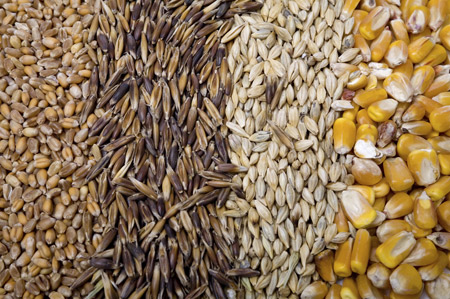 (Agrimoney) – Back in the US, US Department of Agriculture weekly crop data overnight, while showing even more rapid progress in the US harvest than had been expected, held some bullish nuggets too, including the condition estimate for the winter wheat crop.
(Agrimoney) – Back in the US, US Department of Agriculture weekly crop data overnight, while showing even more rapid progress in the US harvest than had been expected, held some bullish nuggets too, including the condition estimate for the winter wheat crop.
That stayed at 59% rated good or excellent.
“The trade was looking for winter wheat condition to improve to 60%,” said Terry Reilly at Futures International.
And the upward march in forecasts for US corn and soybean production has slowed too.
FCStone overnight pegged the US corn crop at 14.783bn bushels, and the soybean harvest at 4.033bn bushels.
These were higher than the figures of 14.475bn bushels and 3.927bn bushels respectively being factored in by the US Department of Agriculture – whose estimates are up for revision on Monday.
But they were lower than FCStone’s previous forecasts of a 14.958bn-bushel corn harvest, and soybean production of 4.066bn bushels.
‘Not as huge an increase’
Linn Group trimmed its corn production estimate by 39m bushels to 14.842bn bushels, albeit on a higher yield forecast of 178.9 bushels per acre, up from, 176.9 bushels per acre.
The USDA has the yield at 174.2 bushels per acre.
For soybeans, Linn pegged production at 4.064bn bushels.
Still, while the market “is looking for USDA to raise demand for US beans, analysts’ estimates are starting to indicate market may not be looking for as huge an increase in production than earlier in October”, said Kim Rugel at Benson Quinn Commodities.
“With the market now looking for increased exports and possibly crush demand, expansion in ending stocks are looking leaner to nil”, compared with the USDA’s current forecasts.
A further idea on the corn and soybean harvests will come at 10.30 Chicago time today, with the release by Informa Economics of its updated crop estimates.
‘Dollars of downside risk’
Still, such harvests are still record high, of course.
Has this factor been undercooked, nonetheless, into futures prices?
“Our dollar remains at multi-year highs, the world stocks-to-use ratio is at an all-time record high and the US stocks will be the most abundant they have been since 2006,” one US broker said.
“Historically we are still at very elevated prices for ag futures and one could make the argument that beans have not pennies but dollars of downside risk.”
Chart appeal weakens
Certainly prices were lower on Tuesday, stoked by fears too that with harvest now speeding up, and storage space running low in some areas, the “final harvest push will push spillover bushels into the pipeline”, Richard Feltes at RJ O’Brien said.
And, signally, some of the technical factors whose improvement last month fuelled the jump in prices, began to unravel.
Soymeal, the market leader in the second half of October, dropped temporarily below its 10-day moving average for the first time in nearly a month before recovering some ground to stand at $370.90 a short ton as of 09:15 UK time (03:15 Chicago time), down 0.5% on the day.
Already, some chart signals at the close of the last session had been showing red.
Soybeans themselves followed suit, shedding 0.7% to $10.22 a bushel for November delivery, and 0.7% to $10.22 ¾ a bushel for the January contract.
Prices fall
Among grains, corn for December dropped, just, back below its 100-day moving average in falling 1.0% to $3.69 ¾ a bushel.
Wheat continued its relative outperformance, helped by the 2015 production concerns for Russia which, as the weekend results of a tender by Egypt’s Gasc indicated, may be not now be pushing quite so hard for business as might have been expected.
Wheat for December fell 0.6% to $5.35 a bushel in Chicago.
The weakness spread to New York cotton too, which fell 0.5% to 63.92 cents a pound, with the overnight USDA data showing the condition of the US crop remaining stable at a respectable 58% rated “good” or “excellent”.
On harvest progress, 50% of the crop is now in the barn, only 1 point behind average, besides a slow week for Texas, the top producing state, where progress advanced only 1 point to 31%, leaving it well behind the average pace.
Overall, “weather forecasts still have some rain in eastern US cotton areas that will briefly interrupt harvesting but is not expect to be neither heavy or sustained enough to do damage crops broadly,” said Tobin Gorey at Commonwealth Bank of Australia.




